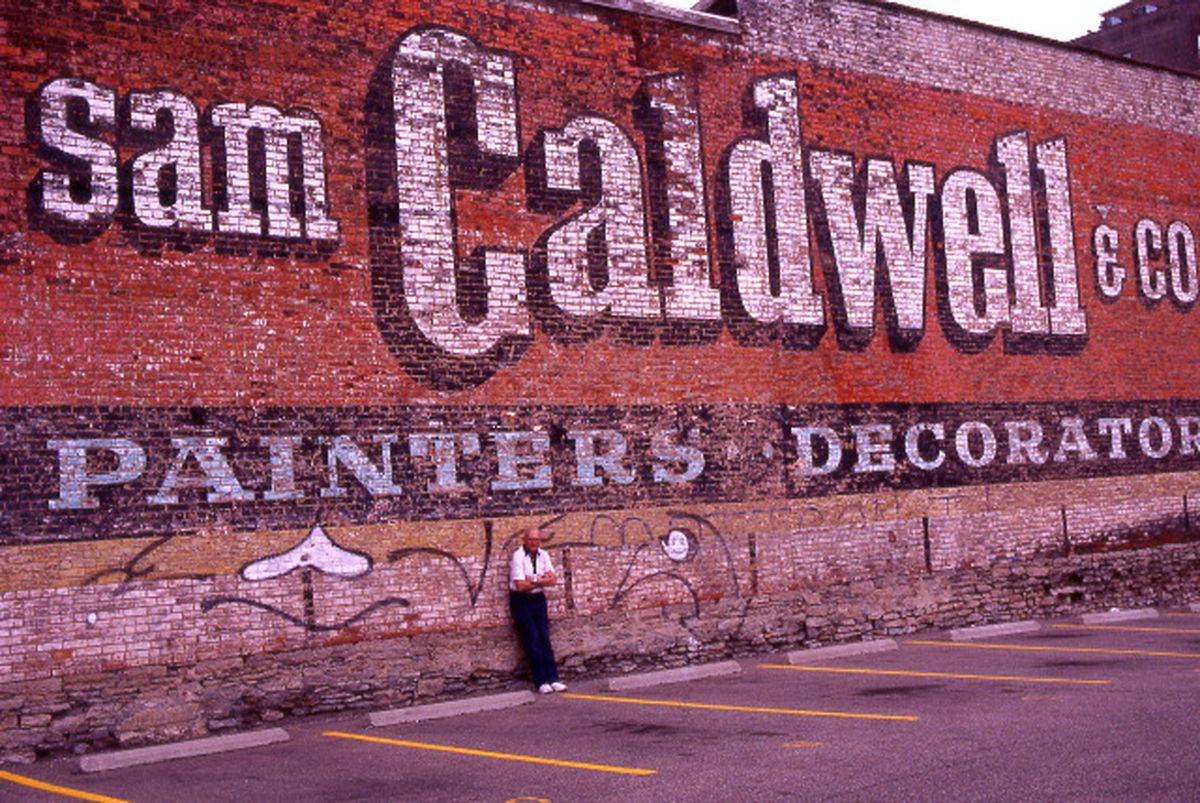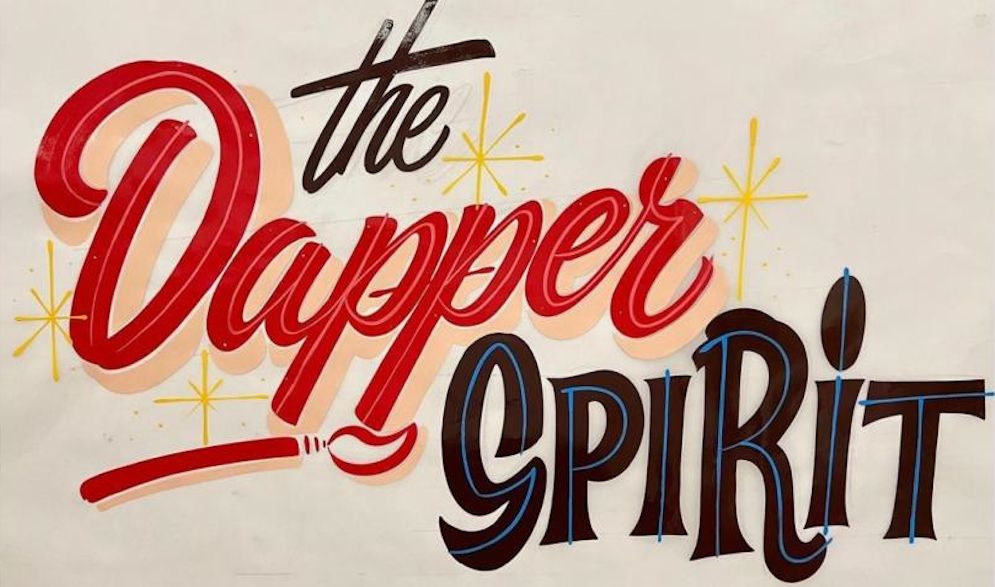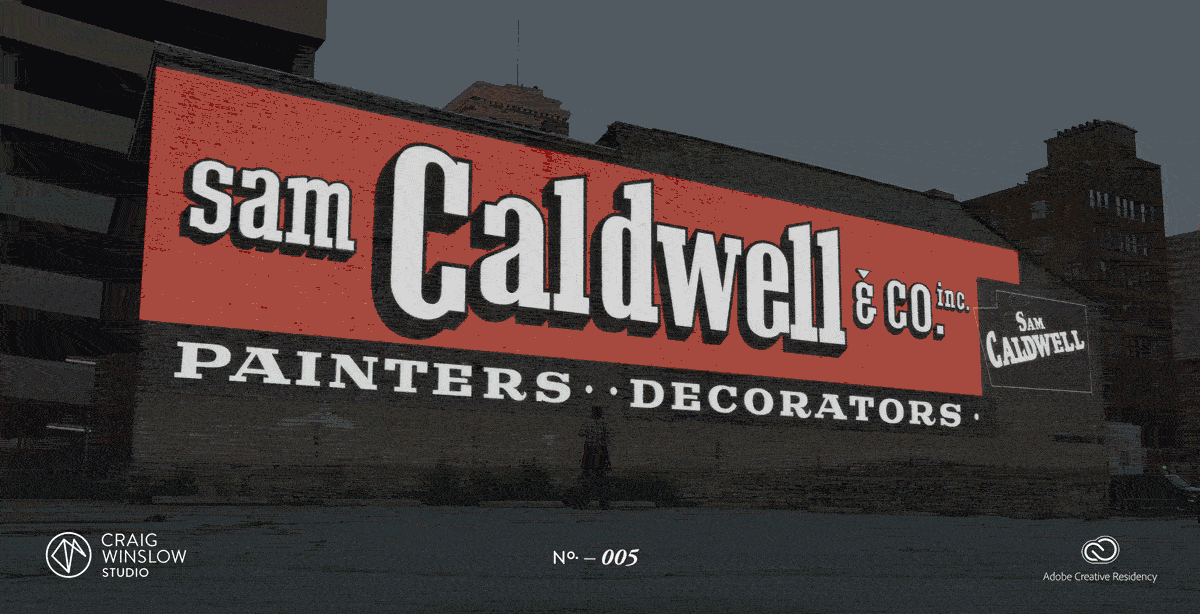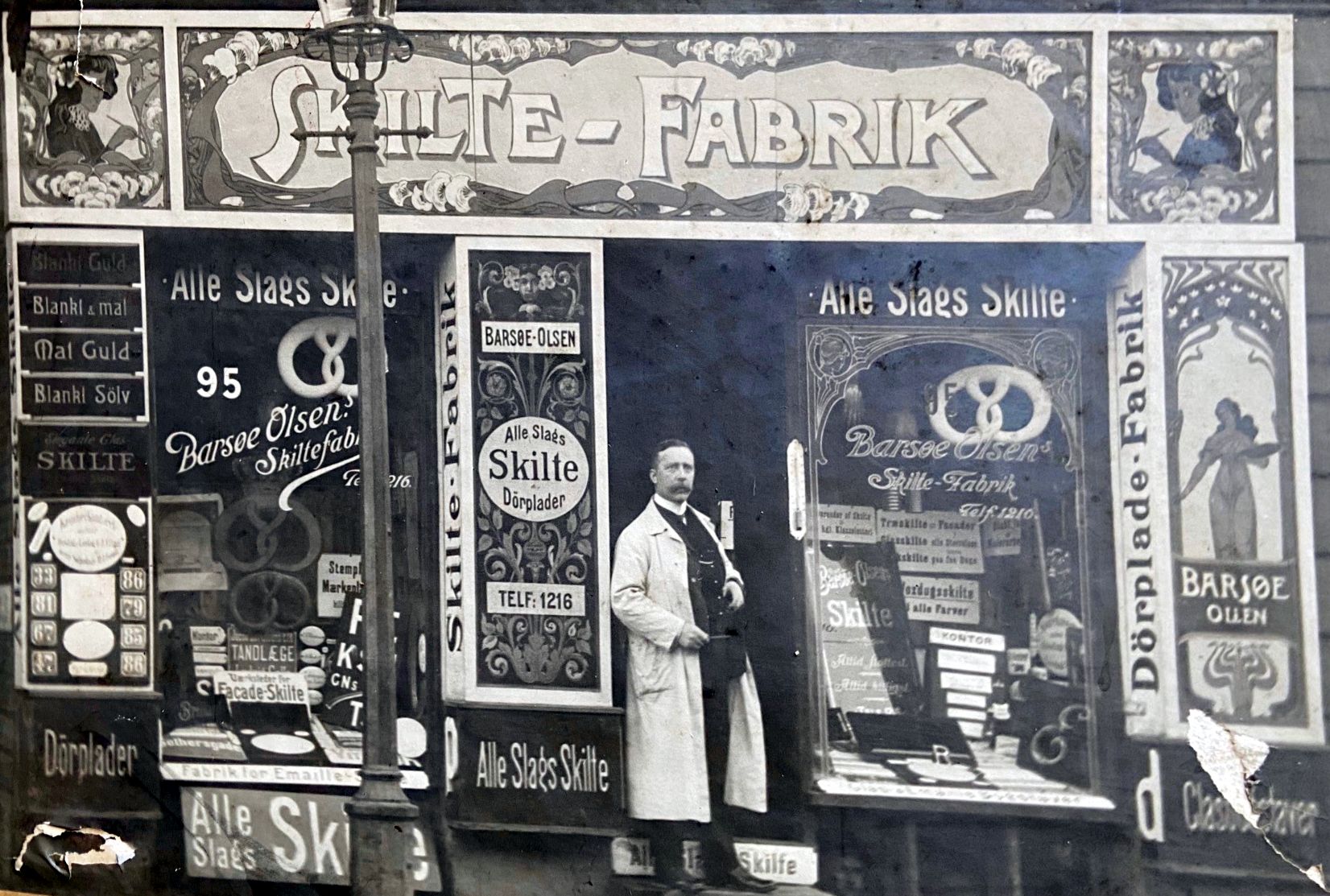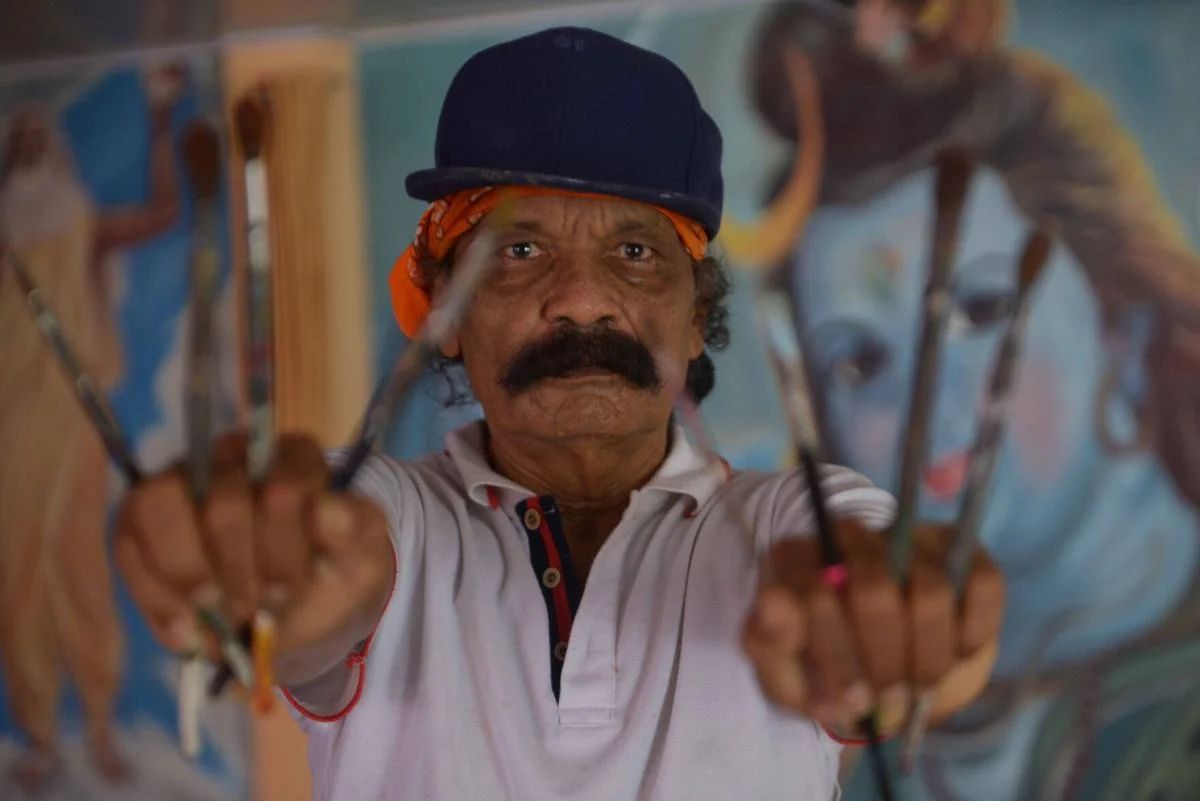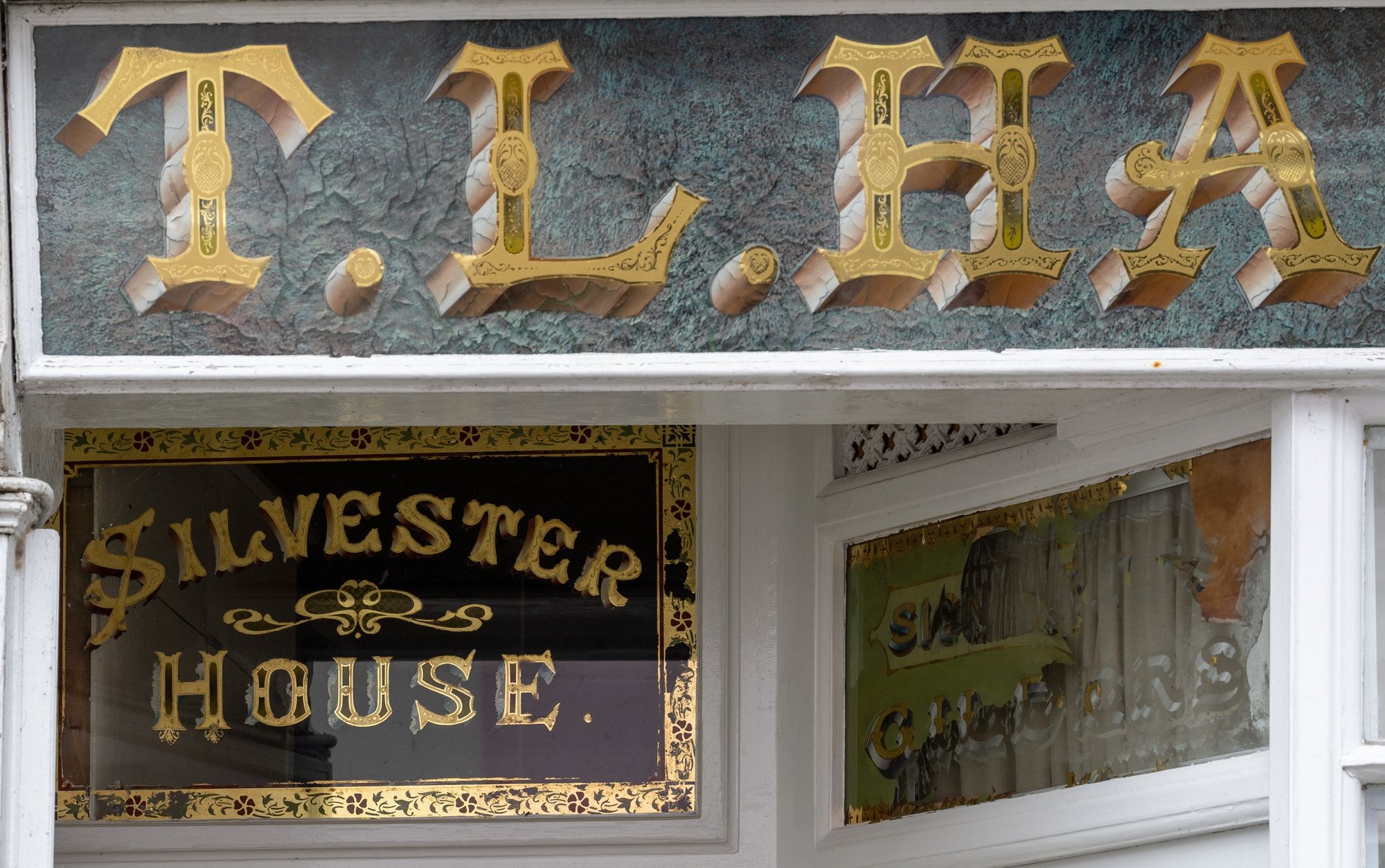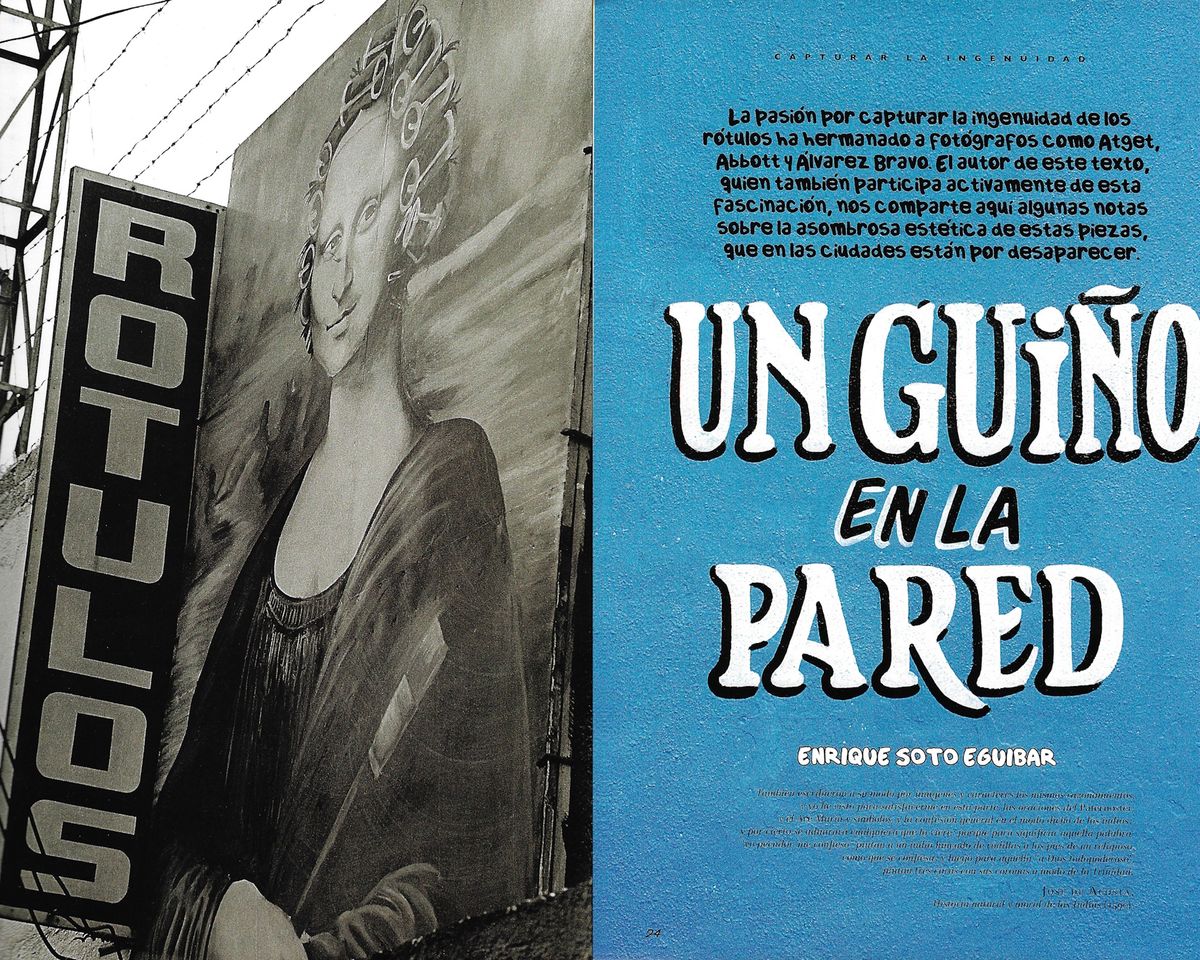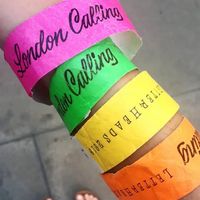|
I have added both these links to last week's post about Cooper.
Those that have seen the Sign Painters film will likely remember the enormous ghost sign that provides the backdrop for Justin Green's interview. This advertised Sam Caldwell & Co., the Cincinnati painting and decorating firm.
Justin Green (RIP) during the filming of Sign Painters in front of the huge Sam Caldwell & Co. ghost sign in Cincinnati. Photos from the Sign Painters Flickr. During our anniversary screening event, director Faythe Levine mentioned that she had a photo somewhere of the man that painted the wall. This led to me being put in touch with his son, Dale Keiger.
Dale wrote about his father's life as a sign painter and wall dog in an essay for Cincinnati Magazine, which was later published in his book, The Man Who Signed the City. He has kindly allowed its reproduction in full here.
Are you ready to join over 400 BLAG members receiving even more adventures in sign painting via full bl.ag online access, event recordings, exclusive monthly email newsletters and, for Blaggers, the magazine in print? BLAG 03, including the limited edition print inside, ships straight away to all new Blaggers, and 04 is coming in December.
Man of Letters
By Dale Keiger
My girlfriend and I were lingering by the display windows of a dirty bookstore. The year must have been 1972 or 1973. We were high school sweethearts, teenagers downtown on a date, probably to see a movie at the Grand or the Albee or perhaps the boxy little duplex Studio Cinemas on Seventh Street. As for the adult emporium, it had made headlines by brazenly opening for business on Vine Street in disregard of the local judiciary, which took a dim view of smut. The commercial space leased by the proprietors had these large windows on two sides, but my girlfriend and I were not peering in to ogle the inventory. The owners had discretely covered the windows with white butcher paper signs inviting 18-and-older Cincinnatians to come in and peruse the racy merchandise. We were amusing ourselves by reading these signs when I thought, Wait a minute. I know that script. Only one sign painter in Cincinnati produced such distinctive italic lettering, simultaneously vigorous and elegant and commercial: my father.
Throughout the 1950s, ’60s, and ’70s, Chuck Keiger was one of the most prolific sign men in the city. He was a wall dog, one of the strong, weathered men who hoisted themselves high in the air on scaffolds to paint advertisements on the expansive exterior walls of downtown buildings. When I was a kid, I could go anywhere in Cincinnati and see his walls, billboards, show cards, and paper signs. I’d spot his lettering on delivery trucks and taxis and Hamilton County police cruisers. Whenever I went to Crosley Field for a Reds game, his work was everywhere—on the scoreboard, on the green outfield walls, on that long white exterior wall that said Crosley Field—Home of Cincinnati Reds in scarlet block letters. For decades, most of Cincinnati’s commercial adornment was done by hand. And often as not, the hand was his.
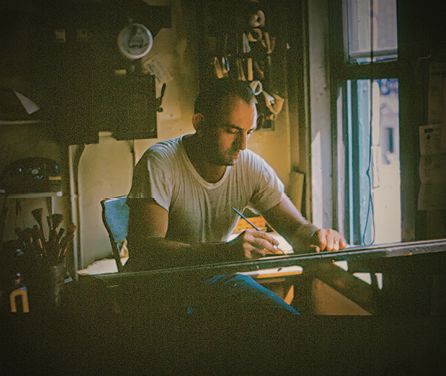 Drawn In: Chuck Keiger at his drawing board in the late 1950s or early 1960s. “He never pictured himself as a working fine artist. But up on that wall? He could see himself doing that.” — Dale Keiger. In 1947, Charles Keiger was home from the Second World War, living with his parents in Cambridge, Ohio, working in a lumber yard and a cement factory and in no apparent hurry to start a career, start a family, or move out of the house. He had always liked to draw, illustrating his high school yearbooks and sending hilarious caricatures of himself home from the bomber base in England where he spent the war. One day his mother, Lelia, reminded him of this affinity for art and suggested he take advantage of the GI Bill of Rights and enroll in art school.
This must have struck him as a good idea. He took a bus to Cincinnati, took a room in the Williams YMCA in Walnut Hills, and spent the next five years studying painting and sculpture at the Art Academy of Cincinnati in Eden Park. He worked in the dish room of the academy’s cafeteria for spending money; wrestled for the YMCA’s team (he’d been a boxer in the Army Air Corps); had more adult fun, I suspect, than he ever admitted to me; and learned how to draw, paint, and wield a chisel. He was a tough, muscular, good-looking man with an intense gaze, receding hair, big ears, and strikingly small hands that could magically make an image appear from a few lines and curves dashed off on a sheet of paper. I got his ears and hands. I did not get his artistic talent.
By 1952, he was just about through the academy and had his eye on a short, lively brunette from Elmore Street in Camp Washington who would become my mother. Walking downtown one day, he spied two men high on a building painting a sign, and thought that looked like work he might enjoy. It was outdoors, it was physical, and it was art, of a sort. Despite his years of training, he had never pictured himself as a working fine artist—“The world doesn’t need any more bad paintings,” he used to tell me—and he didn’t like the idea of spending eight hours a day sitting at a tilt-table in a commercial art studio. But those guys up on that wall? He could see himself doing that. So he walked into the sign painters’ union hall and asked for a job. They sent him to Sam Caldwell.
Sam owned an eponymous sign shop on Ninth Street. My father always recalled him as something of a bon vivant who palled around with Ted Kluszewski and other Reds players and spent more money than he took in. But when my father showed up in 1952, business was good and Sam hired him.
Sixty years ago, American urban geography was not dominated by glass towers and austere cement facades devoid of ornament. On any given block you could find substantial brick warehouses, office buildings, manufactories, and apartment buildings. Many of them had large exposed walls that the buildings’ owners were happy to sell as advertising space. So lots of those walls became signs painted by guys like my dad. Big signs. The buildings might have 10 or more stories and extend for much of a city block, which could make the wall dog’s canvas 80 feet top to bottom and 60 feet side to side. Sometimes bigger.
Sign painters worked in pairs. They would rig what they called lookouts, which were 4×4 wood boards, 12 or more feet long, that had eyes screwed into one end. From the building’s roof, they would haul up the lookouts by rope, place them so they extended a foot or so over the top edge of the wall, and thread ropes through the eyes. These were the ropes that suspended the scaffold on the side of the building; thanks to weights on the back ends and basic Archimedean leverage, the lookouts could bear tremendous weight. The painters would haul the scaffold up the wall hand over hand. There were no brakes—if you were a wall dog, you didn’t let go of the rope. You also didn’t step back to admire your work; the bed of the scaffold was only about two feet deep and there was not much of a back rail.
When they reached the proper height on the wall, they would tie off the lines and start to paint. The first thing to go on the bricks was usually a coat of block-out white, to create a good surface for color and often mask a previous sign. You could always tell a sign man by the speckles of white all over his clothes, boots, hat, and lunch pail. After coating out the wall, the painters would work off of a scale drawing and paint the sign section by section. My father once worked from a design that called for a black background. As he was brushing on the black paint, he found that a bat had taken up residence on one part of the wall. As he got closer, the bat bared its teeth. So Dad painted around it. For the lifespan of that sign, if you looked closely you could spot a white dot high up on the wall. The bat dot.
There were Keiger walls and billboards (which also were done by hand in those days) all over town. A favorite of mine was a huge sign for Rose Exterminator that bore images of a rat, a cockroach, and a silverfish. (No bats.) But the very best were my dad’s signs at the ballpark. That he lettered some cop cars was cool, but that he painted Crosley Field? That was some serious cred for a kid whose buddies were all nuts for baseball. They never understood why I didn’t get free Reds tickets and free Reds stuff, but they were still impressed.
Every March, my father would haul out a dangerous-looking sunlamp and set it on the dinner table. Then he’d put on a T-shirt and dark glasses, open the Post or Enquirer, and turn on the lamp. Painting signs at the ballpark meant two or three weeks of long days in the sun; he made sure to tan his arms and ever more expansive forehead before the job started. I knew Opening Day was not far off when that sunlamp blazed tanning rays from the dining room.
Crosley Field’s outfield walls and scoreboard were covered with signs—Mountain Dew, Webber’s Sausage, Standard Federal Savings, Hudepohl. For many years, atop the scoreboard beside the Longines clock, there was an advertisement for Pontiac, and each year my dad redid the car, updating it to the current model. Back at the shop, he would hand-letter the Cs on the batting helmets, and my schoolyard chums thought that was the coolest of all. When the Reds stunned baseball by winning the 1961 National League pennant, my father headed back to the ballpark to spruce it up for the World Series. While he was working one day, Jerry Lynch, the Reds peerless pinch hitter, smashed a batting practice ball over the wall and Dad brought it home for me in his lunchbox. On media day, he packed his camera and took a little time off to snap pictures of Roger Maris and Mickey Mantle of the Yankees, who took down the Reds in five games and broke my 8-year-old heart.
I didn’t think that much about all of those walls growing up. They were just the backdrop of my childhood. Now whenever I come across a historical photo of Cincinnati, I look for his signs. His work forms a visual record of three decades of commerce, and I wish his name were on some of it. What he did was hard and dangerous and uncelebrated. It took skill and courage and I’m proud of him. As his son, I was always included in the annual Cincinnati sign painters’ Christmas party, which was held in a shop on Vine Street in Clifton and included beer, party trays piled high with cold cuts, and a dozen or so genial men with scuffed hands and big appetites. If there was a new guy at the party, I could tell by the way they introduced me as Chuck’s son that they held my father in high regard.
He stopped climbing walls around 1980, when he was approaching 60 years old. One day he was working from a cherry picker about 10 feet up when he felt himself starting to fall. To at least control how he hit the parking lot, he jumped and the impact shattered his heel. He recovered from the rough landing, counted himself lucky the injuries had been so minor, and then grounded himself, finishing out his career painting show cards—cardboard placards usually propped in windows or placed on easels. Show cards gave him a lot of chances to use the distinctive lettering that I recognized through the window of that dirty bookstore, a flowing, slanted script at once elegant and commercial and readable, calligraphy writ large.
Most of the buildings that bore my dad’s work are gone now. Only one of his walls still stands—the long sign on the side of Sam Caldwell’s vacant shop on Ninth Street. In March 2013, filmmakers Faythe Levine and Sam Macon released Sign Painters, a lovely documentary about the men and women who continue to ply the trade. One of the sign men who appears in the film is Justin Green, a Cincinnati-based sign painter, illustrator, and graphic novelist; at the 11:05 mark, the camera pans away from him and pauses for a few seconds on my father’s last surviving work. I attended the film’s premiere in Washington, and when I saw that I teared up. During the question-and-answer session after the film, I told the filmmakers that the Caldwell wall was my father’s. The audience applauded.
I live in Baltimore now. When I think about the Cincinnati of the first half of my life, I see Chuck Keiger’s signs. I see Rose Exterminator and a Bavarian Beer maiden who was 11 feet from chin to hairline. I see Crosley Field and show cards advertising suits and sports jackets at Dino’s Men’s Clothing. I see white paper with blue italic script in a smut shop’s window. Landscape and still life and portrait painters sign their canvases. My father signed Cincinnati.
Written by Dale Keiger
PS. Sam Caldwell x Light Capsules
The Sam Caldwell sign was the canvass for Craig Winslow's fifth 'light capsule' installation, which acknowledged Chuck Keiger. (Craig's work was recently featured here at bl.ag online.)
More Olde Sign Shoppes
More People
More History
|
